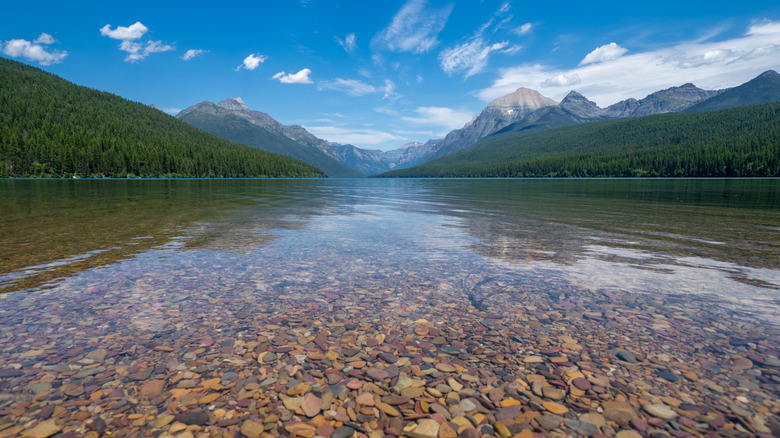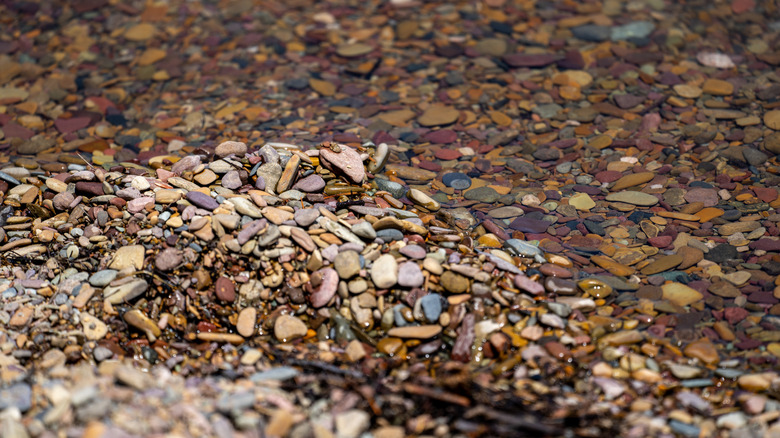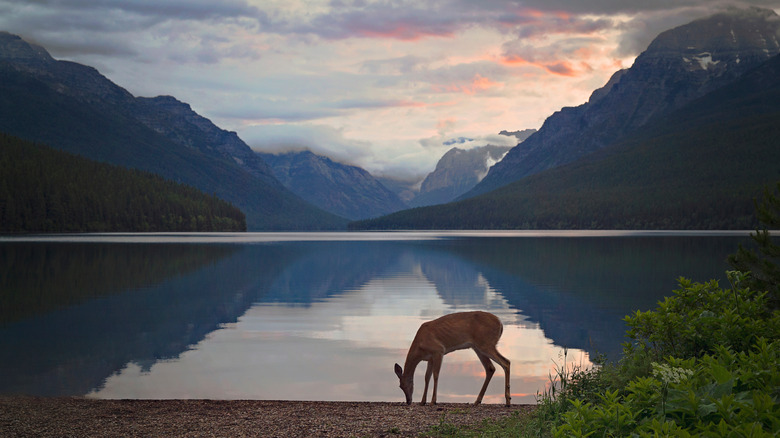Hidden In Montana's Mountains Is A Less Crowded Shoreline With Incredibly Vibrant Rocks Like Lake McDonald
Lake McDonald may be known as the place to see rainbow-colored rocks in a stunning mountain setting, but it's not the only site where you can experience this phenomenon in Montana's Glacier National Park. Perhaps that's no surprise, since according to the National Parks Service, Glacier is home to over 700 lakes, some of which are considered the headwaters for the entire continent and several of which are filled with rocks that span seemingly all the colors of the rainbow. In fact, these are some of the reasons why Glacier National Park has been deemed the "crown of the continent."
Located just a few miles northwest of one of Montana's most picturesque settings is Bowman Lake; Bowman may not be as popular as Lake McDonald, but that doesn't make it any less colorful or stunning. After all, there's lots to love about this glacier-formed lake: vibrant pebbles, crystal clear waters, and snow-capped mountains, plus less crowds than what you'll find at Lake McDonald.
This narrow body of water is about 8 miles long and 1 mile wide, making it the third-largest lake in Glacier National Park. Bowman Lake offers opportunities for hiking, boating, fishing, and camping, making it one of Montana's best hidden gems.
Why are the rocks at Bowman Lake so colorful?
When visiting Glacier National Park, you might find yourself asking one question: why on earth are these rocks so colorful? It comes down to the presence or absence of iron. Red, maroon, and orange rocks all have more iron in them and were in shallow waters, where contact with air oxidized them to give them those colors. Conversely, those in the blue and green part of the color wheel have less iron and were formed in deeper waters. All these rocks were then broken down by glaciers, which crushed them into fragments that rivers then deposited in different areas around the park. The whole process only took 1.6 billion years!
While it would be nearly impossible not to appreciate the incredible beauty of Bowman Lake on its own terms, knowing how these rainbow-colored rocks were formed makes it that much more special. You can enjoy them up close by swimming in the lake, but beware the cold temperature of this glacial water, which is always under 50 degrees Fahrenheit. At least that frigid temperature keeps the water clear since it's too cold for plankton, which may be why Montana has an abundance of otherworldly bright and blue lakes.
You can also BYOB (Bring Your Own Boat) since kayaking and canoeing are allowed at Bowman Lake. Note that you must have your vessel checked by park staff before setting out on Bowman Lake to ensure that there aren't any contaminants or invasive species on it. You can find out more information about boating in Glacier National Park online. For those who'd rather stay dry, there's a picnic area to enjoy views of the blue water and vibrant rocks.
What to know about visiting Bowman Lake
One of the best ways to experience Bowman Lake is to camp there so you can wake up and see the still waters and rainbow rocks as the sun comes up. There are two campgrounds: one on the west end of the lake near the parking area, and a backcountry area on the east, about eight miles away, which you can reach by hiking or boating. You need a permit to stay in the backcountry Head of Bowman Lake campground, which you can obtain online. Both areas are first-come-first-served, and there's more information about securing a site here.
Another way to immerse yourself in Bowman Lake is to explore one of the hiking trails. Besides the Bowman Lake Trail that follows the shore between the two campgrounds, there's also the 6-mile Quartz Lake Trail, which takes you through a densely forested area to Quartz Lake and is part of the longer 12.8-mile Quartz Lake Loop. The Akokala Lake hike is 11.6 miles roundtrip and leads to the small Akokala Lake northwest of Bowman.
The best way to reach Bowman Lake is via Polebridge. From there, it's about a 30-minute drive on six miles of a bumpy, unpaved dirt road, so RVs and trailers are not allowed. You'll need a visitor pass, which you can purchase here. Additionally, timed-registration passes are needed for vehicles; you'll get a two-hour window to enter the park and then can spend however long you'd like there (well, there are some limitations to how long you can spend in a national park). Information about vehicle passes can be found here. Be sure to only take photos and not take any stones home; removal of the rocks is prohibited, as it disturbs the ecosystem of Lake Bowman (and this applies to all of Glacier National Park).


